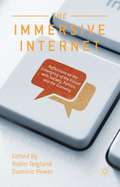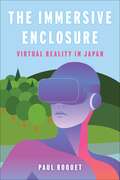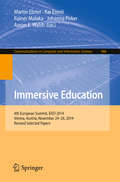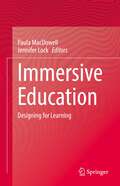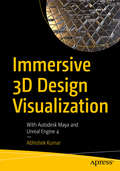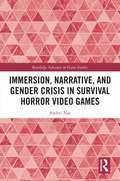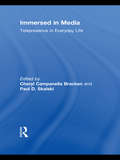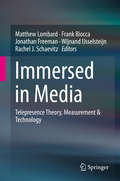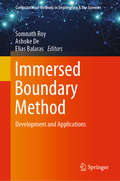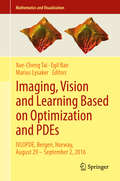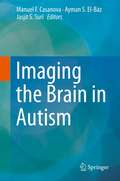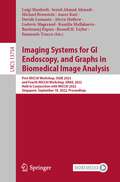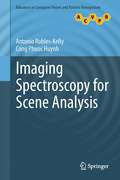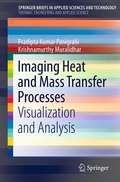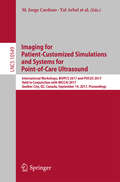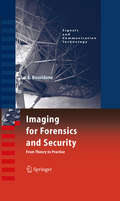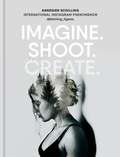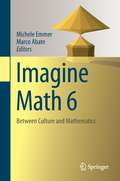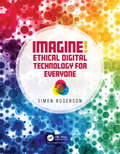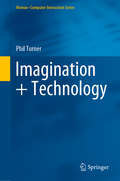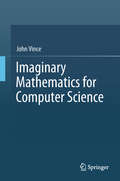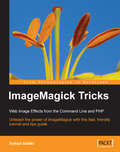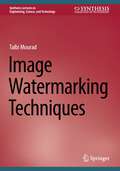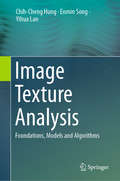- Table View
- List View
The Immersive Internet
by Robin Teigland Dominic PowerCollecting short thought pieces by some of the leading thinkers on the emerging 'Immersive Internet', Power and Teigland's book questions what a more immersive and intimate internet - based on social media, augmented reality, virtual worlds, online games, 3D internet and beyond - might mean for society and for each of us.
The Immersive Enclosure: Virtual Reality in Japan
by Paul RoquetAlthough virtual reality promises to immerse a person in another world, its true power lies in its ability to sever a person’s spatial situatedness in this one. This is especially clear in Japan, where the VR headset has been embraced as a way to block off existing social environments and reroute perception into more malleable virtual platforms. Is immersion just another name for enclosure?In this groundbreaking analysis of virtual reality, Paul Roquet uncovers how the technology is reshaping the politics of labor, gender, home, and nation. He examines how VR in Japan diverged from American militarism and techno-utopian visions and became a tool for renegotiating personal space. Individuals turned to the VR headset to immerse themselves in three-dimensional worlds drawn from manga, video games, and genre literature. The Japanese government promised VR-operated robots would enable a new era of remote work, targeting those who could not otherwise leave home. Middle-aged men and corporate brands used VR to reimagine themselves through the virtual bodies of anime-styled teenage girls. At a time when digital platforms continue to encroach on everyday life, The Immersive Enclosure takes a critical look at these attempts to jettison existing social realities and offers a bold new approach for understanding the media environments to come.
Immersive Education
by Martin Ebner Kai Erenli Rainer Malaka Johanna Pirker Aaron E. WalshThis book constitutes the refereed proceedings of the 4th European Immersive Education Summit, EiED 2014, held in Vienna, Austria, in November 2014. The 11 revised full papers presented were carefully reviewed and selected from 30 submissions. The papers are organized in topical sections on innovation and technological advancements in e-learning; immersive and emerging technologies for cultural and digital heritage.
Immersive Education: Designing for Learning
by Paula MacDowell Jennifer LockThis book focuses on designing and being a designer of immersive education. It introduces readers to the human experiences within immersive learning environments and contributes research evidence on the effectiveness of immersive technologies in K-12 and post-secondary contexts. Through the chapters, illustrative contextual examples and vignettes demonstrate immersive learning in real-world educational practice. Readers will be equipped to design engaging and culturally relevant immersive experiences for learning in a post-COVID world.Immersive Education: Designing for Learning brings researchers, designers, and educators together to offer pedagogical strategies and design guidelines. The originality lies in integrating theoretical and practical knowledge to design meaningful immersive experiences, with attention to sustainability, community, and creativity. Valuable insights are provided to support students and teachers as immersive learning designers and storytellers.
Immersive 3D Design Visualization: With Autodesk Maya and Unreal Engine 4
by Abhishek KumarDiscover the methods and techniques required for creating immersive design visualization for industry. This book proposes ways for industry-oriented design visualization from scratch. This includes fundamentals of creative and immersive technology; tools and techniques for architectural visualization; design visualization with Autodesk Maya; PBR integration; and texturing, material design, and integration into UE4 for immersive design visualization. You’ll to dive into design and visualization, from planning to execution. You will start with the basics, such as an introduction to design visualization as well as to the software you will be using. You will next learn to create assets such as virtual worlds and texturing, and integrate them with Unreal Engine 4. Finally, there is a capstone project for you to make your own immersive visualization scene. By the end of the book you’ll be able to create assets for use in industries such as game development, entertainment, architecture, design engineering, and digital education. What You Will Learn Gain the fundamentals of immersive design visualization Master design visualization with Autodesk Maya Study interactive visualization with UE4 Create your immersive design portfolio Who This Book Is For Beginning-intermediate learners from the fields of animation, visual art, and computer graphics as well as design visualization, game technology, and virtual reality integration.
Immersion, Narrative, and Gender Crisis in Survival Horror Video Games (Routledge Advances in Game Studies)
by Andrei NaeThis book investigates the narrativity of some of the most popular survival horror video games and the gender politics implicit in their storyworlds. In a thorough analysis of the genre that draws upon detailed comparisons with the mainstream action genre, Andrei Nae places his analysis firmly within a political and social context. In comparing survival horror games to the dominant game design norms of the action genre, the author differentiates between classical and postclassical survival horror games to show how the former reject the norms of the action genre and deliver a critique of the conservative gender politics of action games, while the latter are more heterogeneous in terms of their game design and, implicitly, gender politics. This book will appeal not only to scholars working in game studies, but also to scholars of horror, gender studies, popular culture, visual arts, genre studies and narratology.
Immersed in Media: Telepresence in Everyday Life (Routledge Communication Series)
by Cheryl Campanella Bracken"Over the next few decades, immersive media could fundamentally change the ways humans engage in entertainment, communication, and social interaction. The current volume takes a step towards understanding this potential paradigm shift, combining insights from pioneers of the field of ‘presence’ with bright young scholars who bring a new perspective." —Jeremy Bailenson, Stanford University, USA "This book provides an indispensable contribution to scholars in communication studies, computer science and psychology interested in the modes of being present in different media, and offers a careful historical and theoretical framework to the state-of-the-art research."—Anna Spagnolli, University of Padova, Italy "Bracken and Skalski have assembled a collection of works from the world’s foremost authorities on telepresence, a topic that has gone understudied for years. Someone has finally assembled a comprehensive volume on the subject. This book is a must not only for those interested in telepresence, but for mass communication scholars of all kinds."—Kenneth A. Lachan, University of Massachusetts, Boston, USA Immersed in Media highlights the increasing significance of telepresence in the media field. With contributions representing diverse disciplines, this volume delves into the topic through considerations of popular media types and their effects on users. Chapters in the work explain how the experience of presence can be affected by media technologies, including television, video games, film, and the Internet. They also discuss how presence experience mediates or moderates commonly studied media effects, such as enjoyment, persuasion, and aggression. These discussions are accompanied by overviews of the current state of presence research and its future. Ultimately, this work establishes the crucial role of telepresence in gaining a complete understanding of the uses and effects of popular media technologies.
Immersed in Media
by Matthew Lombard Frank Biocca Jonathan Freeman Wijnand Ijsselsteijn Rachel J. SchaevitzHighlights key research currently being undertaken within the field of telepresence, providing the most detailed account of the field to date, advancing our understanding of a fundamental property of all media - the illusion of presence; the sense of "being there" inside a virtual environment, with actual or virtual others. This collection has been put together by leading international scholars from America, Europe, and Asia. Together, they describe the state-of-the-art in presence theory, research and technology design for an advanced academic audience. Immersed in Media provides research that can help designers optimize presence for users of advanced media technologies such as virtual and augmented reality, collaborative social media, robotics, and artificial intelligence and lead us to better understand human cognition, emotion and behaviour.
Immersed Boundary Method: Development and Applications (Computational Methods in Engineering & the Sciences)
by Somnath Roy Ashoke De Elias BalarasThis volume presents the emerging applications of immersed boundary (IB) methods in computational mechanics and complex CFD calculations. It discusses formulations of different IB implementations and also demonstrates applications of these methods in a wide range of problems. It will be of special value to researchers and engineers as well as graduate students working on immersed boundary methods, specifically on recent developments and applications. The book can also be used as a supplementary textbook in advanced courses in computational fluid dynamics.
Imaging, Vision and Learning Based on Optimization and PDEs: IVLOPDE, Bergen, Norway, August 29 – September 2, 2016 (Mathematics and Visualization)
by Xue-Cheng Tai Egil Bae Marius LysakerThis volume presents the peer-reviewed proceedings of the international conference Imaging, Vision and Learning Based on Optimization and PDEs (IVLOPDE), held in Bergen, Norway, in August/September 2016. The contributions cover state-of-the-art research on mathematical techniques for image processing, computer vision and machine learning based on optimization and partial differential equations (PDEs). It has become an established paradigm to formulate problems within image processing and computer vision as PDEs, variational problems or finite dimensional optimization problems. This compact yet expressive framework makes it possible to incorporate a range of desired properties of the solutions and to design algorithms based on well-founded mathematical theory. A growing body of research has also approached more general problems within data analysis and machine learning from the same perspective, and demonstrated the advantages over earlier, more established algorithms. This volume will appeal to all mathematicians and computer scientists interested in novel techniques and analytical results for optimization, variational models and PDEs, together with experimental results on applications ranging from early image formation to high-level image and data analysis.
Imaging the Brain in Autism
by Jasjit S. Suri Ayman S. El-Baz Manuel F. CasanovaData compiled by the Center for Disease Control and Prevention indicates an alarming and continuing increase in the prevalence of autism. Despite intensive research during the last few decades, autism remains a behavioral defined syndrome wherein diagnostic criteria lack in construct validity. And, contrary to other conditions like diabetes and hypertension, there are no biomarkers for autism. However, new imaging methods are changing the way we think about autism, bringing us closer to a falsifiable definition for the condition, identifying affected individuals earlier in life, and recognizing different subtypes of autism. The imaging modalities discussed in this book emphasize the power of new technology to uncover important clues about the condition with the hope of developing effective interventions. Imaging the Brain in Autism was created to examine autism from a unique perspective that would emphasize results from different imaging technologies. These techniques show brain abnormalities in a significant percentage of patients, abnormalities that translate into aberrant functioning and significant clinical symptomatology. It is our hope that this newfound understanding will make the field work collaborative and provide a path that minimizes technical impediments.
Imaging Systems for GI Endoscopy, and Graphs in Biomedical Image Analysis: First MICCAI Workshop, ISGIE 2022, and Fourth MICCAI Workshop, GRAIL 2022, Held in Conjunction with MICCAI 2022, Singapore, September 18, 2022, Proceedings (Lecture Notes in Computer Science #13754)
by Luigi Manfredi Seyed-Ahmad Ahmadi Michael Bronstein Anees Kazi Davide Lomanto Alwyn Mathew Ludovic Magerand Kamilia Mullakaeva Bartlomiej Papiez Russell H. Taylor Emanuele TruccoThis book constitutes the refereed proceedings of the first MICCAI Workshop, ISGIE 2022, Imaging Systems for GI Endoscopy, and the Fourth MICCAI Workshop, GRAIL 2022, GRaphs in biomedicAL Image and analysis, held in conjunction with MICCAI 2022, Singapore, September 18, 2022.ISGIE 2022 accepted 6 papers from the 8 submissions received.This workshop focuses on novel scientific contributions to vision systems, imaging algorithms as well as the autonomous system for endorobot for GI endoscopy. This includes lesion and lumen detection, as well as 3D reconstruction of the GI tract and hand-eye coordination. GRAIL 2022 accepted 6 papers from the 10 submissions received. The workshop aims to bring together scientists that use and develop graph-based models for the analysis of biomedical images and to encourage the exploration of graph-based models for difficult clinical problems within a variety of biomedical imaging contexts.
Imaging Spectroscopy for Scene Analysis
by Cong Phuoc Huynh Antonio Robles-KellyThis book presents a detailed analysis of spectral imaging, describing how it can be used for the purposes of material identification, object recognition and scene understanding. The opportunities and challenges of combining spatial and spectral information are explored in depth, as are a wide range of applications. Features: discusses spectral image acquisition by hyperspectral cameras, and the process of spectral image formation; examines models of surface reflectance, the recovery of photometric invariants, and the estimation of the illuminant power spectrum from spectral imagery; describes spectrum representations for the interpolation of reflectance and radiance values, and the classification of spectra; reviews the use of imaging spectroscopy for material identification; explores the recovery of reflection geometry from image reflectance; investigates spectro-polarimetric imagery, and the recovery of object shape and material properties using polarimetric images captured from a single view.
Imaging Heat and Mass Transfer Processes
by Pradipta Kumar Panigrahi Krishnamurthy MuralidharImaging Heat and Mass Transfer Processes: Visualization and Analysis applies Schlieren and shadowgraph techniques to complex heat and mass transfer processes. Several applications are considered where thermal and concentration fields play a central role. These include vortex shedding and suppression from stationary and oscillating bluff bodies such as cylinders, convection around crystals growing from solution, and buoyant jets. Many of these processes are unsteady and three dimensional. The interpretation and analysis of images recorded are discussed in the text.
Imaging for Patient-Customized Simulations and Systems for Point-of-Care Ultrasound: International Workshops, BIVPCS 2017 and POCUS 2017, Held in Conjunction with MICCAI 2017, Québec City, QC, Canada, September 14, 2017, Proceedings (Lecture Notes in Computer Science #10549)
by M. Jorge Cardoso, Tal Arbel, João Manuel R.S. Tavares, Stephen Aylward, Shuo Li, Emad Boctor, Gabor Fichtinger, Kevin Cleary, Bradley Freeman, Luv Kohli, Deborah Shipley Kane, Matt Oetgen and Sonja PujolThis book constitutes the refereed joint proceedings of the International Workshop on Bio-Imaging and Visualization for Patient-Customized Simulations, BIVPCS 2017, and the International Workshop on Point-of-Care Ultrasound, POCUS 2017, held in conjunction with the 20th International Conference on Medical Imaging and Computer-Assisted Intervention, MICCAI 2017, in Québec City, QC, Canada, in September 2017. The 12 full papers presented at BIVPCS 2017 and the 7 full papers presented at POCUS 2017 were carefully reviewed and selected. The papers feature research from complementary fields such as signal and image processing, mechanics, computational vision, mathematics, physics, informatics, computer graphics, bio-medical-practice, psychology and industry as well as ultrasound image systems applications.
Imaging for Forensics and Security
by Ahmed BouridaneImaging for Forensics and Security: From Theory to Practice provides a detailed analysis of new imaging and pattern recognition techniques for the understanding and deployment of biometrics and forensic techniques as practical solutions to increase security. It contains a collection of the recent advances in the technology ranging from theory, design, and implementation to performance evaluation of biometric and forensic systems. This book also contains new methods such as the multiscale approach, directional filter bank, and wavelet maxima for the development of practical solutions to biometric problems. The book introduces a new forensic system based on shoeprint imagery with advanced techniques for use in forensics applications. It also presents the concept of protecting the originality of biometric images stored in databases against intentional and unintentional attacks and fraud detection data in order to further increase the security.
Imagine. Shoot. Create.: Creative Photography
by Annegien SchillingAnnegien Schilling started her @fetching_tigerss Instagram account when she was 13 years old. Six years later, she has almost 1 million followers worldwide. Her distinctive, surreal images inspire curiosity about the creative process, and in this book, Annegien shares her signature editing style in great detail. She guides her readers through simple step-by-steps to beautiful, surreal imagery and teaches her successful method of conceiving an idea (Imagine), capturing it correctly (Shoot), and editing them efficiently (Create), all without expensive camera gear or complicated software. This book will inspire you to explore your imagination and create photos you never thought possible!
Imagine. Shoot. Create.: Creative Photography
by Annegien SchillingAnnegien Schilling's imaginative self-portraits inspire just under 1 million followers under the account @fetching_tigerss. In this, her first book, she guides her readers through simple step-by-steps to beautiful, surreal imagery and teaches her successful method of conceiving an idea (Imagine), capturing it correctly (Shoot), and editing them efficiently (Create), all without expensive camera gear or complicated software. This book will inspire you to explore your imagination and create photos you never thought possible!
Imagine Math 6: Between Culture And Mathematics
by Michele Emmer Marco AbateImagine mathematics, imagine with the help of mathematics, imagine new worlds, new geometries, new forms. Imagine building mathematical models that make it possible to manage our world better, imagine combining music, art, poetry, literature, architecture and cinema with mathematics. Imagine the unpredictable and sometimes counterintuitive applications of mathematics in all areas of human endeavour. Imagination and mathematics, imagination and culture, culture and mathematics.This sixth volume in the series begins with a homage to the architect Zaha Hadid, who died on March 31st, 2016, a few weeks before the opening of a large exhibition of her works in Palazzo Franchetti in Venice, where all the Mathematics and Culture conferences have taken place in the last years. A large section of the book is dedicated to literature, narrative and mathematics including a contribution from Simon Singh. It discusses the role of media in mathematics, including museums of science, journals and movies. Mathematics and applications, including blood circulation and preventing crimes using earthquakes, is also addressed, while a section on mathematics and art examines the role of math in design. A large selection presents photos of mathematicians and mathematical objects by Vincent Moncorge. Discussing all topics in a way that is rigorous but captivating, detailed but full of evocations, it offers an all-embracing look at the world of mathematics and culture.
Imagine! Ethical Digital Technology for Everyone
by Simon RogersonYou will find in this book a fascinating critical analysis about digital technology from a humanistic perspective.... You will enjoy pictures, poems, stories, and quotations that should encourage self-reflection and community discussion about your real life, your digital life, and the role of technology in society..... This book is oriented towards anyone and everyone, breaking the academic and professional barriers thereby increasing universal awareness of the importance of the ethical concerns surrounding digital technology.—Mario Arias Oliva, Profesor Titular de Universidad Complutense de Madrid. Our dependency on digital technology keeps growing. Are we happy with this? Do we understand the positives and negatives of being so dependent? Imagine! Ethical Digital Technology for Everyone will help everyone to better understand these issues through the use of stories, pictures and poems which explore the world of digital technology. The aim is to demystify and encourage the reader to reflect on how to get the best out of digital technology, but not at the expense of others or of the world at large. This unique book has something for everyone regardless of age, background or technological awareness. It will help to give the reader the confidence to challenge societally unacceptable and promote societally beneficial digital technology offerings. The book is a meeting between technology and the creative arts as our lives become more and more technologically dependent. It aligns with the transition of STEM (Science, Technology, Engineering, and Mathematics) to STEAM (Science, Technology, Engineering, Arts and Mathematics), which aims to promote creativity and curiosity. The book has four facets: short stories, quotations, pictures (many of which are schematics) and poetry about the social and ethical issues surrounding digital technology. Through a lens of creative arts, the book maps the evolution of digital technology from its infancy through to glimpses of the future. This includes many first-hand examples from the 1970s onwards. Alongside this account, surrounding ethical and social issues are portrayed. These two elements are synthesized to encourage thought about how the challenges of evolving digital technology can be met thus leading to social benefit for all of us.
Imagination + Technology (Human–Computer Interaction Series)
by Phil TurnerImagination is highly valued and sought-after, yet elusive and ill-defined. Definitions range from narrowly cognitive accounts to those which endow imagination with world-making powers. Imagination underpins our ability to speculate about the future and to re-experience the past. The everyday functioning of society relies on being able to imagine the perspectives of others; and our sense of who we are depends on the stories our imaginations create. Our soaring imaginations have taken us to the moon and allowed Einstein to race a light beam. Unsurprisingly, imagination underlies every aspect of human-computer interaction, from the earliest conceptual sketches, through the realistic possibilities portrayed variously in well-known tools as scenarios and storyboards, through to the wilder shores of design fictions. Yet, curiously, imagination is very rarely addressed directly in the design and HCI literature (and is wholly missing from virtual reality). This book addresses this gap in our accounts of how we imagine, conceptualise, design and use digital technologies. Drawing on many years of practical and academic experience in human computer-interaction, together with a wide range of material from psychology, design, cognitive science and HCI, seasoned with a little philosophy and anthropology, Imagination + Technology first considers imagination itself and the principal farthings of a new account. Later chapters discuss the role of imagination in the design, aesthetics, use and experience of digital technologies before the concluding chapter focusses on the provocative nature of imagination. The book will be stimulating reading for anyone working in the field of interactive technology and related areas, whether academics, students or practitioners.
Imaginary Mathematics for Computer Science
by John VinceThe imaginary unit i = √-1 has been used by mathematicians for nearly five-hundred years, during which time its physical meaning has been a constant challenge. Unfortunately, René Descartes referred to it as “imaginary”, and the use of the term “complex number” compounded the unnecessary mystery associated with this amazing object. Today, i = √-1 has found its way into virtually every branch of mathematics, and is widely employed in physics and science, from solving problems in electrical engineering to quantum field theory.John Vince describes the evolution of the imaginary unit from the roots of quadratic and cubic equations, Hamilton’s quaternions, Cayley’s octonions, to Grassmann’s geometric algebra. In spite of the aura of mystery that surrounds the subject, John Vince makes the subject accessible and very readable. The first two chapters cover the imaginary unit and its integration with real numbers. Chapter 3 describes how complex numbers work with matrices, and shows how to compute complex eigenvalues and eigenvectors. Chapters 4 and 5 cover Hamilton’s invention of quaternions, and Cayley’s development of octonions, respectively. Chapter 6 provides a brief introduction to geometric algebra, which possesses many of the imaginary qualities of quaternions, but works in space of any dimension. The second half of the book is devoted to applications of complex numbers, quaternions and geometric algebra. John Vince explains how complex numbers simplify trigonometric identities, wave combinations and phase differences in circuit analysis, and how geometric algebra resolves geometric problems, and quaternions rotate 3D vectors. There are two short chapters on the Riemann hypothesis and the Mandelbrot set, both of which use complex numbers. The last chapter references the role of complex numbers in quantum mechanics, and ends with Schrödinger’s famous wave equation. Filled with lots of clear examples and useful illustrations, this compact book provides an excellent introduction to imaginary mathematics for computer science.
ImageMagick Tricks
by Sohail SalehiSohail Salehi is an experienced computer graphics artist, working with 2D, 3D, and video graphics. The book shows his techniques in action. This is no laborious walk through of ImageMagick, with one dull example after another. The chapters consist of workshops, each one applying a set of ImageMagick commands to produce surprising and exciting results. As you read the book, you will learn the features of ImageMagick as well as getting lots of inspiration and ideas for how you can use it in your own projects. You'll be amazed by the creative results you can achieve using code.
Image Watermarking Techniques (Synthesis Lectures on Engineering, Science, and Technology)
by Talbi MouradThis book investigates the image watermarking domain, analyzing and comparing image watermarking techniques that exist in current literature. The author’s goal is to aid researchers and students in their studies in the vast and important domain of image watermarking, including its advantages and risks. The book has three chapters: image watermarking using data compression; speech modulation for image watermarking; and secure image watermarking based on LWT and SVD.In addition, this book: Investigates the image watermarking domain, analyzing and comparing current image watermarking techniquesIncludes detail on image encryption and mathematical tools used for image watermarkingCovers image watermarking using data compression, speech modulation for image watermarking, and more
Image Texture Analysis: Foundations, Models and Algorithms
by Chih-Cheng Hung Enmin Song Yihua LanThis useful textbook/reference presents an accessible primer on the fundamentals of image texture analysis, as well as an introduction to the K-views model for extracting and classifying image textures. Divided into three parts, the book opens with a review of existing models and algorithms for image texture analysis, before delving into the details of the K-views model. The work then concludes with a discussion of popular deep learning methods for image texture analysis.Topics and features: provides self-test exercises in every chapter; describes the basics of image texture, texture features, and image texture classification and segmentation; examines a selection of widely-used methods for measuring and extracting texture features, and various algorithms for texture classification; explains the concepts of dimensionality reduction and sparse representation; discusses view-based approaches to classifying images; introduces the template for the K-views algorithm, as well as a range of variants of this algorithm; reviews several neural network models for deep machine learning, and presents a specific focus on convolutional neural networks.This introductory text on image texture analysis is ideally suitable for senior undergraduate and first-year graduate students of computer science, who will benefit from the numerous clarifying examples provided throughout the work.
